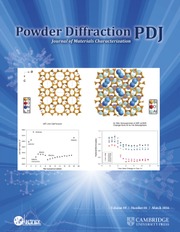Article contents
Multireflection RIR and intensity normalizations for quantitative analyses: Applications to feldspars and zeolites
Published online by Cambridge University Press: 10 January 2013
Abstract
Quantitative determination of phase abundances using X-ray powder diffraction is a technique in wide use today. Of the various methods employed, the Chung, or RIR method, is one of the most common because it can provide reliable results for all sample types. However, improvements can be made to the Chung method of analysis for phases which exhibit large chemical or preferred orientation effects. These effects can often be accommodated by using intensity regions that encompass several reflections, by averaging intensities from nonparallel reflections, or by using RIR values that are allowed to vary based on a predetermined functional relationship. To accommodate the effects of preferred orientation and variable composition in feldspars, RIR values versus the intensity ratio between two peaks of feldspar standards mixed with corundum have been determined. Curves of RIR have been formulated for: (1) feldspar RIR13.0−14.0° versus the intensity ratio (13.0–14.0° 2θ intensity region/27.0–28.75° 2θ intensity region); (2) feldspar RIR23.6° peak versus the intensity ratio (23.6° 2θ peak/27.0–28.75° 2θ intensity region); and (3) clinoptilolite RIR020 versus (020 reflection/22.1–23.0° 2θ intensity region). For example, RIR values for the highly variable 13.0–14.0° 2θ region for feldspar can be improved such that the quantitative results produced has a standard deviation of only 15% instead of 53% using a fixed-average value. From these curves, improved RIR values can be obtained for the quantitative analysis of unknowns. Additionally, intensity ratios can be determined between two peaks of a phase so that given the intensity of one peak, the intensity of the other peak can be readily calculated. This allows for subtraction of the intensity of a peak from one phase overlapping a peak from a second phase which is to be used for quantitative analysis but which cannot be decomposed by profile fitting.
Information
- Type
- Research Article
- Information
- Copyright
- Copyright © Cambridge University Press 1995
References
- 81
- Cited by

